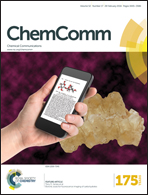A highly active Pd–P nanoparticle electrocatalyst for enhanced formic acid oxidation synthesized via stepwise electroless deposition†
Abstract
A highly active Pd–P nanoparticle electrocatalyst for formic acid oxidation was synthesized using NaH2PO2 as the reducing agent. The Pd–P nanoparticles were amorphous and exhibited higher specific and mass activity values compared to commercial Pd/C electrocatalyts and reported literature values. Furthermore, the Pd–P nanoparticles were found to be more durable than Pd/C electrocatalyts.


 Please wait while we load your content...
Please wait while we load your content...